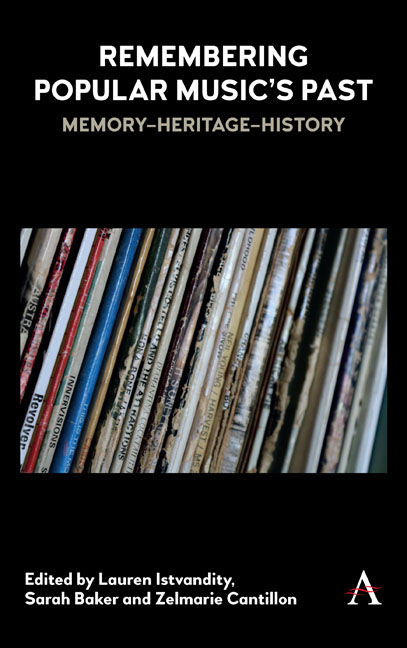Book contents
- Frontmatter
- Contents
- List of Figures
- Acknowledgements
- Chapter 1 The Precarity of Memory, Heritage and History in Remembering Popular Music's Past
- Part I MEMORY
- Chapter 2 Consuming Popular Music Heritage
- Chapter 3 ‘Back in the Day’: Experiencing and Retelling the Past as a Claim to Belong in the Current Northern Soul Scene
- Chapter 4 Resilience and Change: Popular Folk Songs in a Cultural Landscape
- Chapter 5 Remembering the Independent Record Shop: The Ordinary Affects of Leedin Records
- Chapter 6 Mean Streets as Heritage Object: Music, Nostalgia and the Museumification of Martin Scorsese
- Part II HERITAGE
- Part III HISTORY
- List of Contributors
- Index
Chapter 4 - Resilience and Change: Popular Folk Songs in a Cultural Landscape
from Part I - MEMORY
Published online by Cambridge University Press: 09 July 2019
- Frontmatter
- Contents
- List of Figures
- Acknowledgements
- Chapter 1 The Precarity of Memory, Heritage and History in Remembering Popular Music's Past
- Part I MEMORY
- Chapter 2 Consuming Popular Music Heritage
- Chapter 3 ‘Back in the Day’: Experiencing and Retelling the Past as a Claim to Belong in the Current Northern Soul Scene
- Chapter 4 Resilience and Change: Popular Folk Songs in a Cultural Landscape
- Chapter 5 Remembering the Independent Record Shop: The Ordinary Affects of Leedin Records
- Chapter 6 Mean Streets as Heritage Object: Music, Nostalgia and the Museumification of Martin Scorsese
- Part II HERITAGE
- Part III HISTORY
- List of Contributors
- Index
Summary
Introduction
The predominant Western association of landscape with visual art shapes the way many people think about and experience the world –as subject/ object relationship, merely as ‘something seen’ (Rose 2006; Wylie 2006) and often with a focus on the iconic, the aesthetic and the rural. Landscape characterization takes a broader and deeper view of the landscape. It recognizes that contemporary landscape is deep and diverse in origin and is cultural, being ‘created in the present day by our own cultural and social attitudes’ (Fairclough 2008, 409). Characterization also recognizes landscape as ubiquitous: that landscape is heritage, and heritage is landscape. Landscape, therefore, is not the environment (Hogg 2015, 282), but rather a relationship (negative and positive) between people and their environment. The landscape is not just shaped by human behaviour, it also shapes it by contributing to the formation of local culture and identities (Devadoss 2017, 72). The complex interweaving of tangible forms (buildings, monuments, the physical manifestations of human interaction within the landscape) and the intangible representations of behaviour, including music and song, is encapsulated by the same landscape. It is our contention that these relationships are not yet fully appreciated, and that one element of the intangible heritage –folk music, which we regard as historic popular music, or folk music within a popular context, then and now –has a significant contribution to make towards readings and understandings of landscape. The boundaries between music categories are fluid, and folk music does not represent a lost legacy but a continuing and popular engagement with territory. The emotional connections of people and their landscape are clearly expressed through this form of popular music, with its arguably unique ability to capture and mentalize intimate associations through time (Chikowero 2015).
These related perspectives facilitate the recognition of tensions within the landscape, as well as its dynamic and creative nature, and provide the opportunity to read it through other senses (Basso 1996; Hogg 2015) –to smell or hear the landscape, to encounter it in multi-sensory and complex ways (Porteous 1996, 33–38). Psychologists have proven that music is a strong stimulus for all kinds of memory (Huron 2006; Szpunar et al. 2004; van Dijck 2006). Crucially, though, music also recognizes and represents local distinctiveness, evoking memory of place and sharpening the emotional reactions people have for a place and for the environment around it (Storey 2006, 80).
- Type
- Chapter
- Information
- Remembering Popular Music's PastMemory-Heritage-History, pp. 41 - 54Publisher: Anthem PressPrint publication year: 2019



